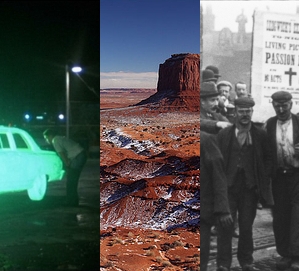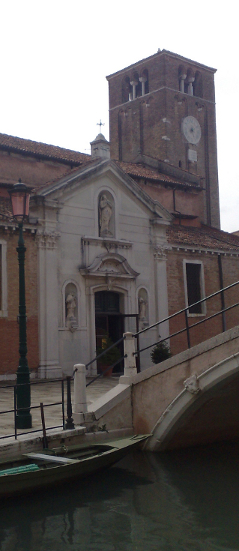Film is defined as much by its’ content and form as it is by it’s context. A boring discussion could be had volleying about film theory ‘til the cows come home on such a broadside, but film is about how we personalise the viewing experience; the company we kept, the events that led up to the screening, the location and quality of the material itself. A small revolution in mainstream film criticism could be enacted were critics not forced into a room full of other grumpy men on a Monday morning to watch the latest GenericRomCom®.
 Regional cinemas have tremendous history of tapping into the value of films of local relevance. From the birth of Cinema, with the factory gate films of Mitchell & Kenyon in the North of England, but also in recent history with special screenings or the director Q&A for titles of local interest. Entrepreneurial spirits have even taken it a step further with rolling projection booths that can show John Ford westerns in Monument Valley, or Repo Man in an abandoned lot in downtown LA. Using the immediate locale to bolsters the core cinema experience beyond that of mere consumption is about as great as cinema gets.
Regional cinemas have tremendous history of tapping into the value of films of local relevance. From the birth of Cinema, with the factory gate films of Mitchell & Kenyon in the North of England, but also in recent history with special screenings or the director Q&A for titles of local interest. Entrepreneurial spirits have even taken it a step further with rolling projection booths that can show John Ford westerns in Monument Valley, or Repo Man in an abandoned lot in downtown LA. Using the immediate locale to bolsters the core cinema experience beyond that of mere consumption is about as great as cinema gets.
With cinema drifting away from the communal experience more and more, the value of the private experience of a film needs to be considered. It might make filmmakers cry (or piss and moan) to think of people watching a film on a phone or a laptop, but loss of quality aside how does watching a film in 40 min bursts on the plane/train/automobile commute affect a viewers’ digestion of a film? How might that come to affect filmmaking in 20 years time?
 My decision to kill an evening travelling through Venice by watching Nic Roeg’s Don’t Look Now was a personal experience which went above and beyond the norms of most bricks-and-mortar cinema experiences. Fighting exhaustion and sleep deprivation on arrival, I opted for a film on the laptop over idle and banal conversation with the gaggle antipodean travellers that filled the hostel I was staying at. For my sins I’d never got around to Don’t Look Now, and by gum if this wasn’t the time and the place to catch up with this British classic.
My decision to kill an evening travelling through Venice by watching Nic Roeg’s Don’t Look Now was a personal experience which went above and beyond the norms of most bricks-and-mortar cinema experiences. Fighting exhaustion and sleep deprivation on arrival, I opted for a film on the laptop over idle and banal conversation with the gaggle antipodean travellers that filled the hostel I was staying at. For my sins I’d never got around to Don’t Look Now, and by gum if this wasn’t the time and the place to catch up with this British classic.
The viewing wasn’t in-and-of-itself too horrific, and my proximity didn’t bleed into the experience of consuming the film. The frantic build up to the twist-I-already-knew-by-osmosis was pretty intense, but the film was over before I knew it. A few interesting echoes to Antichrist, the meaning of parenthood, loss, subjective memory, and so forth and so on. Still, yes, lovely, good film, lights out, time for sleep.
 While my sleep didn’t feel broken, I didn’t realise quite how stupid I was to leave the processing of a film like that to my slumbering self. At breakfast the next day I learnt from my Australian room-fellows that for reasons unknown I was repeatedly calling out and screaming at five in the morning in a language wholly foreign to them. I’m not prone to night-terrors in the least, but then I guess an unconscious exception had to be made for Don’t Look Now.
While my sleep didn’t feel broken, I didn’t realise quite how stupid I was to leave the processing of a film like that to my slumbering self. At breakfast the next day I learnt from my Australian room-fellows that for reasons unknown I was repeatedly calling out and screaming at five in the morning in a language wholly foreign to them. I’m not prone to night-terrors in the least, but then I guess an unconscious exception had to be made for Don’t Look Now.
 Walking around the city the next day I can’t say I was particularly weirded out by my experience (and nocturnal response) to the film. The city was the same, though the pale and washed out colours of a wintery Venice felt a world away from the sweltering day of Indian summer I was experiencing. Anorak-ish compulsion forced me to track down the church being restored in the film (the eglise San Nicolo dei Mendicoli). But that wasn’t particularly cathartic. A very nice church, which surprisingly makes zero mention of the film, or its production, anywhere in it. It’s just another church in Venice, just a bit off the beaten track.
Walking around the city the next day I can’t say I was particularly weirded out by my experience (and nocturnal response) to the film. The city was the same, though the pale and washed out colours of a wintery Venice felt a world away from the sweltering day of Indian summer I was experiencing. Anorak-ish compulsion forced me to track down the church being restored in the film (the eglise San Nicolo dei Mendicoli). But that wasn’t particularly cathartic. A very nice church, which surprisingly makes zero mention of the film, or its production, anywhere in it. It’s just another church in Venice, just a bit off the beaten track.
Strolling about in the evening was a little eerier, as it recalled the claustrophobic, echoing back alleys which Donald Sutherland seems to endlessly be running through in the film. The fact that you can be completely isolated one minute, and in the middle of a high street the next is strangely unique to the historical architecture of Venezia, and is unnerving enough without the recollection of Sutherlands waking dreams. The strange parallel between the crowded ‘real’ or conscious world, and the labyrinthine unconscious world and its’ lurking shadows/killers is an obvious if extremely effective one, really underpinning the flitting perspective between premonition and reality. The city’s casting is absolutely integral to this, and it’s a small miracle that Venice as a location hasn’t been done to death in horror films since. Only the recent Shark in Venice seems to think of the city as a natural backdrop for terror, and that was shot in Bulgaria.
 Getting back and re-watching the film in the comfort of my own home I can’t say I was able to find any obvious seeds of deep set horror in it. I can only assume the film is actively working on levels I cannot even begin to comprehend. Which is terrifying in its’ own right, but this does explain how the film manages to both grow in the memory and get better and better on successive viewings. By all means watch it where you like on what you like, just don’t watch it before going to bed, in Venice.
Getting back and re-watching the film in the comfort of my own home I can’t say I was able to find any obvious seeds of deep set horror in it. I can only assume the film is actively working on levels I cannot even begin to comprehend. Which is terrifying in its’ own right, but this does explain how the film manages to both grow in the memory and get better and better on successive viewings. By all means watch it where you like on what you like, just don’t watch it before going to bed, in Venice.